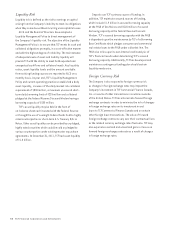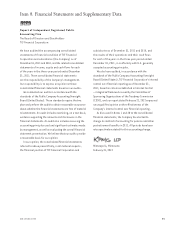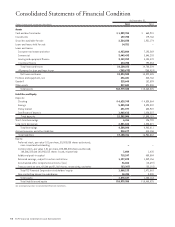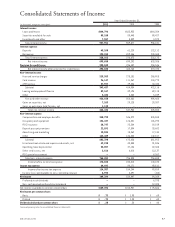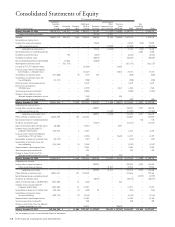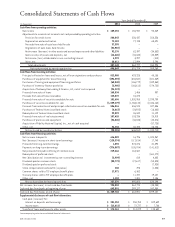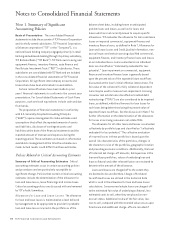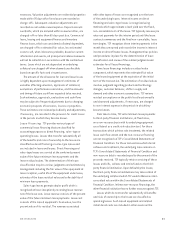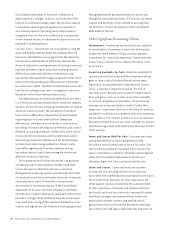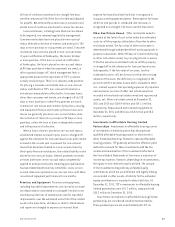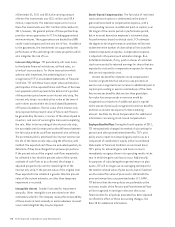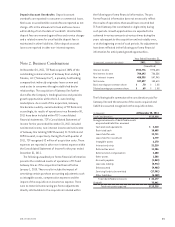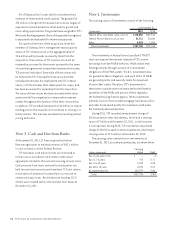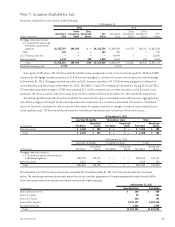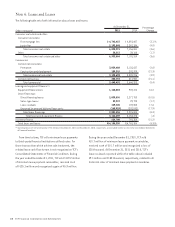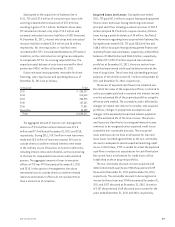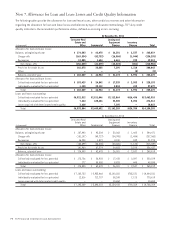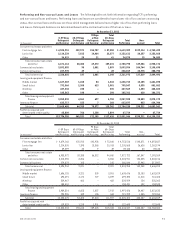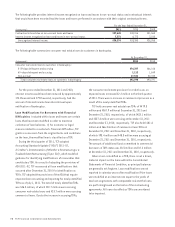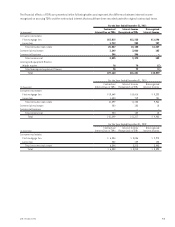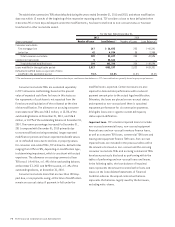TCF Bank 2011 Annual Report Download - page 82
Download and view the complete annual report
Please find page 82 of the 2011 TCF Bank annual report below. You can navigate through the pages in the report by either clicking on the pages listed below, or by using the keyword search tool below to find specific information within the annual report.of December 31, 2011 and 2010, the carrying amount
of these five investments was $22.1 million and $29.4
million, respectively. The maximum exposure to loss on
these five investments was $22.1 million at December 31,
2011; however, the general partner of these partnerships
provides various guarantees to TCF including guaranteed
minimum returns. These guarantees are backed by a BBB
credit-rated company and limit any risk of loss. In addition
to the guarantees, the investments are supported by the
performance of the underlying real estate properties which
also mitigates the risk of loss.
Interest Only Strips TCF periodically sells auto loans
to third party financial institutions, at fixed rates, on
a limited-recourse basis. For those transactions which
achieve sales treatment, the underlying loan is not
recognized on TCF’s Consolidated Statements of Financial
Condition. TCF sells these loans at par value and retains a
participation in the expected future cash flows of borrower
loan payments which represents the deferral of a portion
of the purchase price known as an interest only strip. The
interest only strip is recorded at fair value at the time of
sale in other assets within the Consolidated Statements
of Financial Condition. The fair value of the interest only
strip represents the present value of future cash flows to
be generated by the loans, in excess of the interest paid to
investors, and costs of servicing the loans and completing
the sale. After initial recording of the interest only strip,
the accretable yield is measured as the difference between
the fair value and the cash flows expected to be collected.
The accretable yield is amortized into interest income over
the life of the interest only strip using the effective yield
method. The expected cash flows are evaluated quarterly to
determine if they have changed from previous projections.
If the present value of the original cash flows expected to
be collected is less than the present value of the current
estimate of cash flows to be collected, the change is
adjusted prospectively over the remaining life of the
interest only strip. If the present value of the original cash
flows expected to be collected is greater than the present
value of the current estimate, an other than temporary
impairment is recorded.
Intangible Assets Goodwill is tested for impairment
annually. Other intangibles are amortized over their
estimated useful life. The Company reviews the recoverability
of these assets at least annually or earlier whenever an event
occurs indicating that they may be impaired.
Stock-Based Compensation The fair value of restricted
stock and stock options is determined on the date of
grant and amortized to compensation expense, with a
corresponding increase in additional paid-in capital, over
the longer of the service period or performance period,
but in no event beyond an employee’s retirement date.
For performance-based restricted stock, TCF estimates
the degree to which performance conditions will be met
to determine the number of shares that will vest and the
related compensation expense. Compensation expense
is adjusted in the period such estimates change. Non-
forfeitable dividends, if any, paid on shares of restricted
stock are recorded to retained earnings for shares that are
expected to vest and to compensation expense for shares
that are not expected to vest.
Income tax benefits related to stock compensation
in excess of grant date fair value less any proceeds on
exercise are recognized as an increase to additional paid-in
capital upon vesting or exercise and delivery of the stock.
Any income tax benefits that are less than grant date
fair value less any proceeds on exercise would be
recognized as a reduction of additional paid in capital
to the extent of previously recognized income tax benefits
and then as income tax expense for the remaining
amount. See Note 16, Stock Compensation for additional
information concerning stock-based compensation.
Employee Benefits Plans During the fourth quarter of 2011,
TCF retrospectively changed its method of accounting for
pension and other postretirement benefits. TCF’s prior
policy was to report net actuarial gains and losses as a
component of stockholders’ equity in the Consolidated
Statements of Financial Condition on an annual basis.
TCF’s policy for actuarial gains and losses is now to
immediately recognize them in its operating results in the
year in which the gains and losses occur. Additionally,
for purposes of calculating the expected return on plan
assets, TCF will no longer use an averaging technique for
the market-related value of plan assets, but will instead
use the actual fair value of plan assets. While both the
prior and new policies are permitted under U.S. GAAP,
TCF believes that the new policies are preferable as the
economic results of the Pension and Postretirement Plans
will be recognized in earnings in the year they occur.
Financial data for all periods presented has been adjusted
to reflect the effect of these accounting changes. See
Note 28 for additional information.
64 TCF Financial Corporation and Subsidiaries


